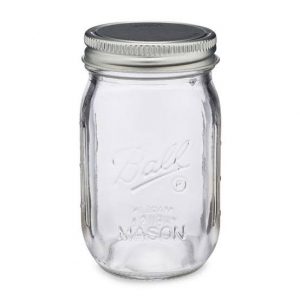Table of Contents
Choosing the right paint
Choosing the paint to use is the first hurdle you have to jump because not all types of stains are ideal for glass; not all of them stick to the glass properly. Also, some that do stick may not last long before they start removing. You have to ensure that you get the right paint to prevent damaging the glass jar because some stains can discolor the pot or make it hard to paint on again. The best type of paint suitable for mason jars is either acrylic or enamel paints. However, you must check to ensure that they can be used on glass without any issues because not all brands are designed for glassworks.
The color of the paint also matters. Regardless of the type of color you settle for, you should also consider the paint’s transparency. Some people may fancy light paints that allow them to see through the jar while some don’t. Whatever color or level of transparency you settle for should be in line with the plan you have in mind for your mason jar, including its potential use.
Preparing the Mason Jars
After settling on your preferred paint, all attention is turned to the mason jar(s). The first step is to ensure that the jar is clean, dry, and contains no impurities as this will affect the finish positively. Just a little impurity, such as a speck of dirt, can adversely affect finishing the painting by leaving bumps. Therefore, the jar must be sparkling clean before you start painting.
Another thing you don’t want on or inside your jar before painting is water. Apart from causing discoloration in some parts of the glass, it may not allow the paint to touch the areas you want the color to feel. It leads to an undesirable paint job as some areas will be deprived of color at the end. It is even worse if the water is inside and you intend to paint inside of the jar. Therefore, ensure that the pot is well dried using whatever material can dry wet surfaces, for example, a dry cloth.
Finally, ensure that the surface on which you are painting your mason jars is protected from splashes, drips as well as dust.
Painting the Mason Jars
You can paint masons jars in different ways, and all the method depends on the tool you intend to use to paint, which can be a standard painting brush, spray cans or paint guns, etc.
You don’t need any particular skill or style. If you are painting with a standard brush, all it takes is your brush, paint, and the jar. Dip the brush into the paint and then paint the jar the same way you will paint any other surface. However, it would be best if you were consistent in all areas regarding the painting’s thickness and smoothness. You can achieve this by not dipping the brush fully into the paint at all times as it will help reduce drips and more inconsistent layers.
Spray cans or paint guns can be used to paint small objects with impressive precision. However, you have to ensure that you are not spraying close to a surface you don’t want the paint to touch.
Also, smaller brushes like those with the size of a regular pen can cover areas that were missed by the bigger standard brush. They can be used to correct mistakes, make your work neater, and be time-saving.
Drying the Mason Jars
After painting, the next and final step before you start using your mason jars is to dry them. However, this is not as straightforward as one would have expected. Unlike flat surfaces, mason jars have openings, meaning that all the sides do not get dried evenly immediately. If you painted the exterior alone, then the Mason jar should get dried quickly. However, if you paint either the jar’s interior or both the exterior and the jar’s interior, you have to pay more attention when drying the pot.
As expected, they take longer to dry in areas where they are exposed to light, so shun such areas when drying them. To speed up the drying process, place the jars directly under sunlight or on a windowsill. If you put them on a window sill, one side of the pot will dry faster than the other side. Therefore, observe the dried areas and turn the wet areas towards the direction of the light. It should help the paint get dried faster.
If you are not in haste to start using your mason jars, you can leave allow the pots to dry slowly. Some of the dividends of this wait is a mason jar with consistent color as well as coverage. It helps to improve the jars’ display quality. So, if you have the time, ensure that you keep the jars at a place with less human traffic and are out of reach for children and pets if you want to reap the benefits of your wait.

